by Tom Gaylord, a.k.a. B.B. Pelletier
I sort of backed into this report several weeks ago when I reported on shooting my .250 Savage with 10 “first” shots. Actually, I waited long enough between each shot that the barrel cooled down to the ambient temperature so the rifle “thought” it was shooting its first shot. The actual first of the 10 shots was a little wide of the rest of the group, probably because the bore had been cleaned and was just a bit oily — but also because it went off before I was ready. I’d forgotten how light the trigger was on that rifle. After that, though, the gun settled down and put the next 8 rounds into a very nice group that was centered on the bull. The last shot was a called pull to the right.
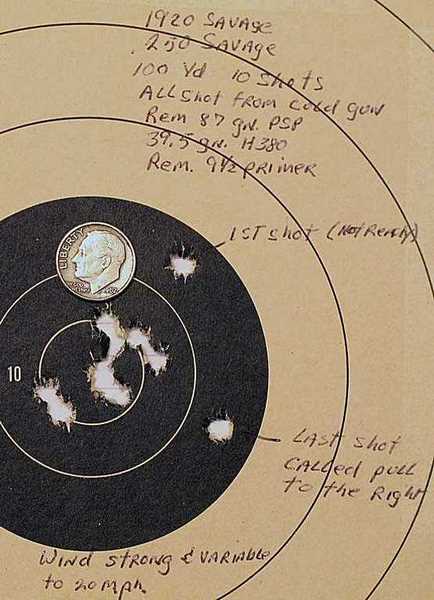
Eight tight first shots out of 10 at 100 yards from my .250 Savage.
That target and experience got me wondering whether an airgun could also put all of its first shots in the same place. So, I devised a test to see what would happen. Today, I’m reporting on the outcome.
Initially, I’d said that to be a true first shot a long time had to pass between each shot. I thought hours would be appropriate, and a full day would be even better. There’s no scientific reasoning behind those times — it’s just something that I came up with.
I initially put an entire day between each shot, but that proved to be too much of a burden. To shoot, I have to set up a light on the target, set up a shooting bench with sandbag and a chair, and I have to clear the furniture out of the intervening space. So, at shot No. 3, I resolved to shoot two shots per day and leave the shooing bench and light set up all day. There would be about 5 hours between each shot on any given day.
This is hard!
Right off the bat, I discovered that this is the hardest shooting test I’ve ever done. Because I wasn’t shooting but a single shot, I wasn’t giving myself time to warm up as a shooter — to heck with the rifle. It took from 2 to 5 minutes to settle in for the shot, and each shot was a first shot, so they were as scary as all first shots are. In that respect, I think this was a true test of both the gun and the shooter. If you’ve never tried something like this, you owe it to yourself to try it at least one time. I think you’ll see how difficult it is if you really try to shoot the very best you can.
My test rifle was my Beeman R8 that I’ve shown you several times in the past. It’s tuned to be very smooth and has always been able to shoot a small group on command, so I thought it might also be good for this kind of test.
The best pellet in this rifle has been the JSB Exact RS that weighs just 7.3 grains in .177 caliber. It’s extremely stable in this rifle and seems to forgive many faults on the shooter’s part — something I would need for certain.
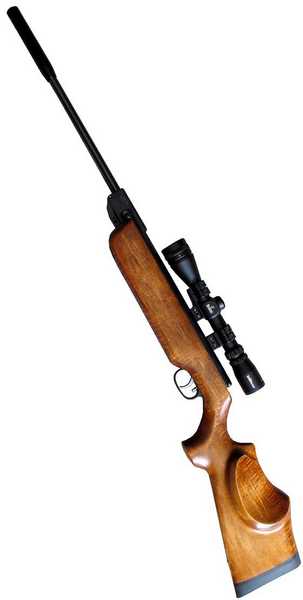
This Beeman R8 is tuned, so it shoots to the point of aim.
What are we testing?
With the .250 Savage, I was testing the ability of the rifle to put the first bullet where I wanted it to go. A centerfire rifle will often throw the first bullet wide of the mark, either because the barrel is cold or, more likely, because it has an oily film which lubricates the bullet differently than all the bullets that follow. An airgun acts differently, because different things are happening. First, since we don’t routinely clean our barrels, you don’t have the oily film problem. If it’s a springer you’re shooting, the grease is stiff on the first shot and looser afterwards. If it’s a PCP, the valve tends to stick on some guns with the first shot.
But we’re also testing the shooter. I usually need a couple shots to get into the groove every time I shoot — and I shoot almost every day of the week. A shooter who shoots less often than me will probably need more shots — just to warm up and remember all his shooting techniques. But you don’t get that with a first shot. It’s right then or never — no do-overs. And that was what affected the outcome of this test as much as anything, I think.
The results
What follows is a photo record of 10 shots. It starts with two shots and ends with 10. After that, I’ll shoot another 10-shot group, after settling in, so we can compare the difference.
Two shots from the R8 at 25 yards. So far, so good.
1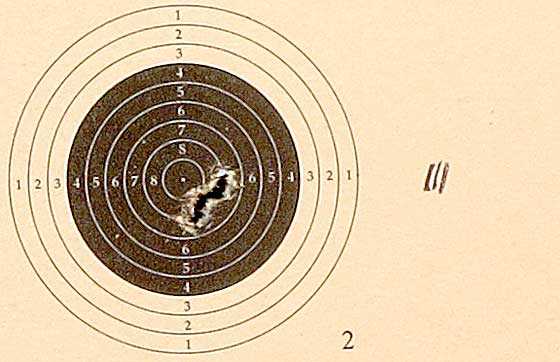
Shot three enlarged the group quite a bit.
After the third shot, I abandoned the need to wait a day between shots and shortened it to not less than 5 hours. I did that for the reasons already mentioned.
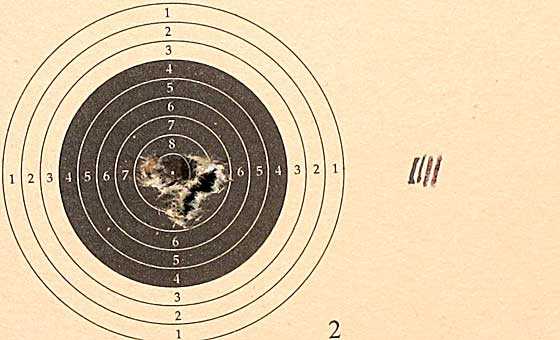
Shot four went on the other side of the aim point, which is the dot at the center of the target. I’m in danger of losing my aim point.
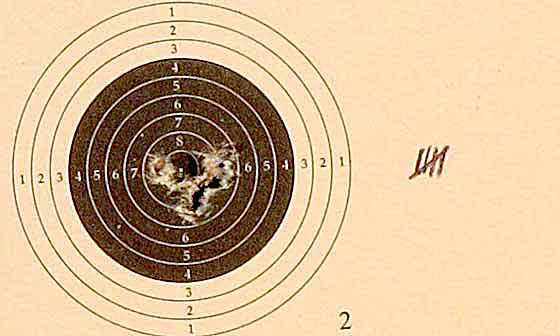
Shot 5 enlarged the right side of the group a little.
About at this point, I observed that this is a very difficult way to shoot targets! Every shot takes settling in, which a first shot doesn’t really afford; so you have to spend extra time getting set up. It was taking me 3 to 5 minutes to settle in for every shot, and that’s no exaggeration. And, even then, I always wondered if there was any tension left in me that might throw a shot wide of the mark. As you will see, that can happen all too easily.
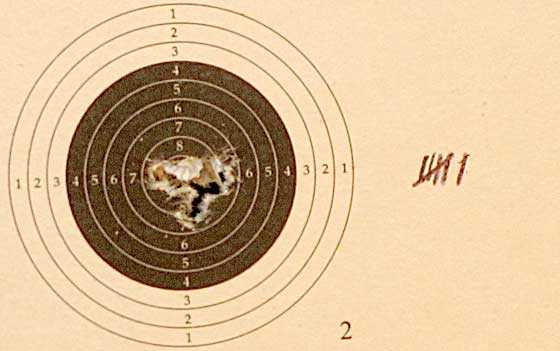
Shot 6 joined the hole to the left with the group on the right, making it look better. It also removed the aim point. It was guesswork from this point on.
At this point in the test, I was feeling that the gun was going to perform as I knew it could. And that was all it took to make me relax my setup for the next shot.
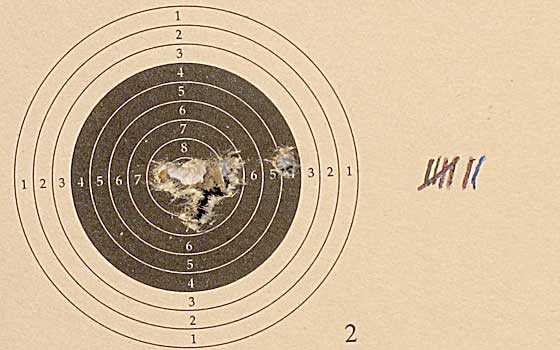
And that is all it takes! By rushing the setup for the 7th shot, I left some sideways tension in my hold. I knew the tension was there, but I thought the rifle would compensate for me and still drill the center.
Let my 7th shot be a lesson to everyone. When shooting for the tightest group, you absolutely cannot leave anything to chance, nor can you take anything for granted! I know that very well, and you can see the results of it in the group at the top of this report. But I got careless this one time and look what it cost me.
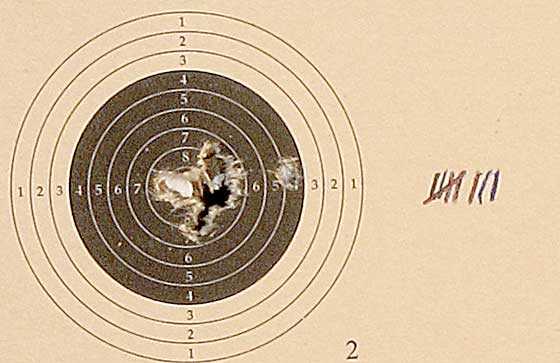
Shot 8 is back in the main group — of course.
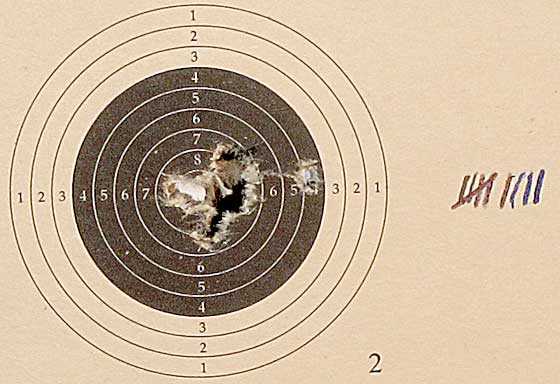
You can’t tell where shot 9 went, so it’s somewhere in the main group.
At this point you know how this is going to turn out. The rifle is accurate, even if I slip up occasionally. And shot 7 is staring me in the face, reminding me to not do that. One more shot to finish the group, and I probably was the most careful with this one.
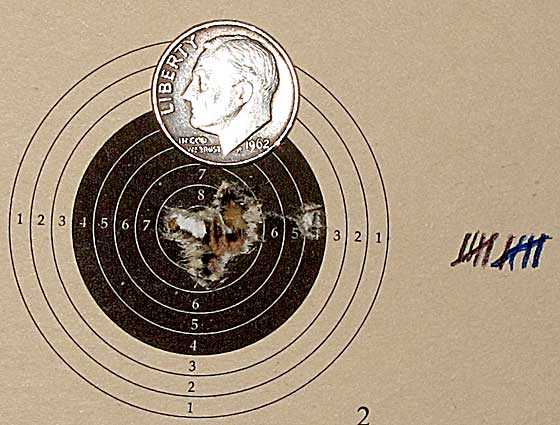
And there you have it. Ten shots — all of them the first shot from a cold gun. Only one “flyer” that we all know is not a flier at all.
Shot 7 now appears to be a “flier” in this group. But we know differently. We know what caused it to go wide was technique — not a bad pellet, scope shift or any other lame excuse. I just shot bad that time.
We also suspect that the R8 is a first-shot rifle. In other words, there’s no need to warm it up to get the best results. But I still need to do one more thing to prove that it is. I need to shoot the best group I can — which will be shot all at the same time.
To get ready for the group I shot 5 pellets at another target to get myself into the groove. Once I knew I was there, I shot a final 10-shot group with the same gun and pellet at the same 25 yards.
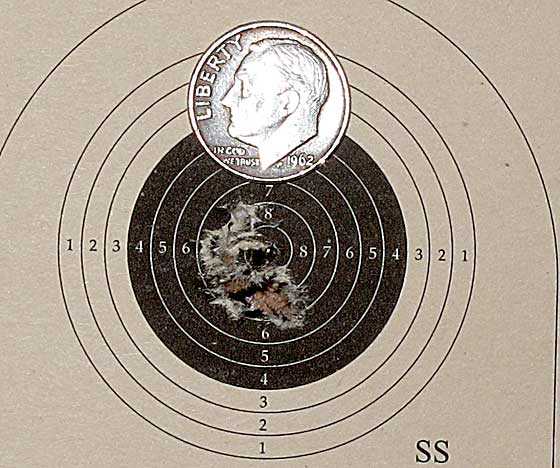
This is what I can do under the same conditions, when I shoot all 10 shots at one time. The rifle isn’t more accurate — I just make fewer mistakes.
What have I learned?
For starters, I know that this R8 is a stable gun. It doesn’t have to be limbered up to shoot its best. That doesn’t translate to other air rifles, though. Each gun will be unique, and some of them will have to be warmed up to shoot where you aim.
I also learned how difficult it is to put the first shot where I want to. Actually, I sort of knew that already — this test just forced me to see it more clearly.
Does this apply to other powerplants, as well?
I think it applies to all guns — air-powered or firearm. But I suppose I need to test it to see for sure.
What’s coming
Just as a reminder, I’ve been writing a number of reports about the basics, or what I call the components of accuracy. Last December, I did one on velocity versus harmonics, and I’m still referring back to that 11-part test to see the lessons.
Dennis Quackenbush has long been intrigued by the same thing: What makes a gun accurate? One of the things he and I have discussed over the past decade is rifling twist rates. And I have learned a lot about twist rates in the past 5 years from my firearms shooting. Most of it was what not to do; but, still, it was stuff I didn’t know.
Dennis kindly offered to help me perform a little experiment with twist rates for pellets. We selected the AirForce Talon SS as a testbed because the barrels are so easy to change, and Dennis made two special .22-caliber barrels for the rifle. One has a 1:12 twist rate (that means the pellet rotates one time in 12 inches of barrel), and the other has a 1:22 twist. The standard barrel has a 1:16 twist rate; so by shooting groups with all three barrels, we’ll be able to compare the performance.
AirForce helped out by furnishing the exterior barrel dimensions, plus they supplied the barrel bushings for the barrels. I have these barrels now and am set to start testing very soon. Before I do, I’d like the blog readers to give me their thoughts on what I should do to perform this experiment.

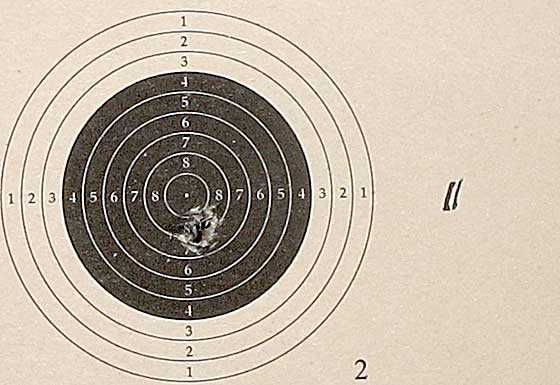
I’ve never performed a test like this.
I have had many first (and second) shots hit far from the aimpoint when I’ve begun shooting a springer. Honestly, in my case, I think it’s about getting into a routine rather than warming up the gun. I’m still going to blame it on the gun though.
Wow, the proposed test with 3 different barrels with different twist rates on an adjustable platform like the Talon SS could become a book. Shooting different pellet weights, in different barrels at different powers could result in a large tome.
I remember when someone associated with this blog feared that they would run out of airgun topics many years ago LOL!
kevin
B.B.,
You’ve established that psychology plays a big role in this kind of test, as is the case with many tests.
Of course, consistent performance is a function of the quality of the gun. The question is, how much warming up does a lessor gun require before it can shoot with precision?
The issue of psychology might be helped if just before the test you practiced with another gun that is most similar. I think it would be worth doing since the purpose of this test is not to challenge the shooter, but rather to see how consistent a cold gun performs.
I think that your last ten shot group might have been better for this test if you hadn’t primed the rifle with 5 practice shots. I wonder how the rifle performs going from absolute cold and continuing on through 10 shots.
============================================================================================
Regarding your 3 barrel twist-rate test:
1. I wonder how pellet weight matches with twist-rate? In other words, does a lighter pellet benefit from a higher twist rate, or a heavier from a lower?
2. For a given pellet weight, does the best twist rate extend flight stability and thus accuracy over a longer distance? I’m considering the possibility that within a certain distance, like say 35 yards, all twist rates might appear to perform the same, but that beyond that distance the trajectory starts to diverge at a faster rate for one or two less-optimal twist rates.
There are some interesting dynamics here that could be of particular interest to hunters (i.e., guys who want to extend the range of their shooting).
Victor
Victor…
How many shots to “warm up” ? It is something you have to find out for yourself for the particular gun…..
The easy ones….
You shoot the same gun every day indoors. You only have to worry about what it is going to do after sitting overnight. AND…. If it is a PCP, how many shots to settle after a fill. AND….how many shots to settle after cleaning the barrel if you clean it.
The hard ones….
You have a bunch of guns that you shoot more or less frequently, and do so under considerably different conditions. What do you need to do with any particular one that you pick up? What are you going to do just to make sure ?
Some things you have to learn and live with. Hunters need to learn what their guns will do when subjected to extreme temperature differences. They also need to learn what to expect with wind, elevation angles, and variable distance. And then there is the problem of never shooting from the same position twice. You have to know what the gun will do, what it will let you get away with, and what your own limitations are. It can take a while to figure out.
twotalon
TT,
Try the test yourself. Then you’ll know all those things.
B.B.
TT,
I’m thinking more of a controlled environment to limit the variables. I was also thinking more in terms of a spring-piston power-plant. I have shot springers that seemed to throw the first shot out when cold. I haven’t done a lot of shooting in over a year and a half, but as I recall I also think that I’ve seen the aim-point change. My thoughts are that I’ll need to do this test for myself with several rifles.
One big question is, how much time does it take for a springer to cool off? 1 day? 4 hours? 1 hour?
Victor
Victor
Instead of asking how long it takes an airgun to cool off (if taken in the literal sense), you should be asking this…..
What is different between B.B.s’ R8 and airguns that DO need a “warmup shot” (or several)?
Seals and lubes would probably be the main part of the answer.
twotalon
TT,
You are correct, and that is what I was thinking. I was thinking about my springers, and not B.B.’s R8 because it doesn’t seem to need to “warm up”. Looks like I’ll need to run my own tests.
Victor
Hi guys !Hope that everybody is doing ok ,here in Croatia most of us prayed for all caught on the hurricane Sandy path ?I have a good news ,my mother has had a heart transplantation last week and she is doing fine !Once again thank you all for the support you guys gave me ,God bless you all!
Milan….
All of my best wishes go to you and your mother. I hope that her recovery is fast and without problems.
twotalon
Great news, Milan!
/Dave
We here in Croatia are lucky(at least in one thing 🙂 ) because Croatia is part of Eurotransplant program so our waiting lists are not that long actually (thank God ) …
Milan,
Thank you so very much for sharing your good news with us. My neighbor had a heart transplant about 10 years ago. our prayers are with your mother for a speedy recovery.
Bruce
Mr B. TEN YEARS God bless you man 😀 !!!-I hope that my mum will live at least 10 yrs now ,thank YOU for sharing this information …
Milan,I know I am LATE to the party,but I too am very thankful of this news.It seems multi-national prayers have been answered! I am so happy for you my airgun friend!
Amen my friend !And you are not ‘ late ‘ ,in fact your comment has made my day even better ,God bless you ;D !
Doing the Happy Dance here. (You are soooo lucky you cannot see it.)
I am,and through the positive response of you guys I can completely see it -thank you Gene this world still has a good people ,and some of the best are on this blog 😉 !
YAY for your mom and you Milan! I’m really happy for you and your familly!
J-F
Great news, Milan!
I wish your mother and you all the best and the fastest possible recovery.
duskwight
Now, if all goes well I will legalize my air rifles (I need to do it before 01.06.13′.)…Once again thank you all :)!
Milan,
I’m glad to hear that your mother’s operation went well. Now, we’ll pray for a speedy recovery.
B.B.
Thank you B.B. 🙂 !
Milan,
Prayers going up for your mom and the entire family.
Edith
Thank you Edith:D -this is the most supportive forum I have been a part of (and i am proud if I ever did contributed to help someone on this blog ) ,you guys are great:) !
Milan,
This is the news we’ve all been waiting for! I’m happy for you and your mom.
-Chuckj
Thank you and Chuck and how much wood would a woodchuck chuck if a woodchuck could could chuck wood ;D ,I know you guys almost every day I check this blog ;),and yes this is what I learned :)!
Milan,
I’ve said this before but I never get tired of it: “He’ll chuck as much wood as a woodchuck could if a woodchuck could chuck wood.” 🙂
-woodChuckj
LOL 🙂
Excellent news. Glad to hear it. “More things are wrought by prayer than this world dreams of.”
Matt61
That is so good to hear!
May she have a full recovery!
Les
Matt,Desertdweller -I guess there IS still enough love to go around ! 🙂
Milan,
I am so glad to know that your mother is doing fine. Now she needs to follow her doctors best advice and take her recovery one step at a time.
Victor
Milan, that is great news and I hope your mom will recuperate before long and have many more years to share. ~Ken
Is the standard barrel choked? What of the other two? That could possibly have some effect on accuracy.
RR,
The standard barrel is choked. The other two probably are not. So that will play a factor in the test.
B.B.
B.B.
I hope that this 3 barrel test does not bite you. Three different barrels that are supposed to be the same will never be perfectly the same in the first place.
As Victor said, you might have to stretch the distance out some to see how fast the groups fall apart.
If you are only looking for accuracy at one fixed distance, then refer to my first statement……they are three different barrels no matter what the twist rate is.
twotalon
TT,
Yes, we thought about that. But we’re looking for large affects — not fractions of an inch. So if there is a significant improvement, we’ll see it. At any rate, we are going where no one has gone (in print) before.
B.B.
B.B.
The tests you devise (which I love!) often produce as many questions as they do answers. But I think you like that, and this test reflects that. I remember several years ago you talked about always having a pesting air rifle ready to shoot that you knew exactly what it would do with its first shot.
In a certain way, aren’t springers always a first shot rifle? The physical act of doing a major shift in your body position to cock and load the gun, straining your muscles, then having to settle back in and relax all over again. What if you had a “gun bearer” who would gently take the gun between shots and cock it and carefully load it just as you would, and slip it back into position as you held your preferred shooting position at the bench? So it was just as if you were shooting a semi auto? Might that give a springer an even better chance of showing what it can do? Not a real word shooting situation, but that is what bench rest shooting is all about, isn’t it?
Lloyd-ss
Now Lloyd…….Don’t you think Edith has ENOUGH stuff to do??? LOL
5+3 does not equal 8 this morning. Long post lost…
You can usually hit the back button of your browser (I know it works on Chrome) it even tells you to hit the back button and your post will be there, just as you left it before entering the capchat. I just tried it with this post by entering the wrong answer on purpose.
It happens to me all the time on a automotive blog where they have silly questions or others where you have to re-write the words. I think what happens is the question “times out” if the page stays open too long.
J-F
A hard test indeed! For those interested….
“Cold” one shot test results. All shots taken at a measured 27 yds from the muzzle, seated and resting the guns on my hand on the kitchen counter. Shortest elapsed time between shots- 7 hours. Longest elapsed time- 26hours. No pellets were sorted. All scopes were set on 7x. Benjamin 397 has stock open sights, no scope. I live at about 5500 ft above mean sea level.
I did a quick 5 shot chrony after the test was complete and included the results the results for anyone curious. On all of the guns, the velocity steadily climbed from cold 1 st shot to warmed up 5 th shot:
TF99, .22 JSB Exact Jumbo Heavy 18.0gr 545 fps ave, 11.87 ft/lbs-16.10 Joules, 1-7/8” group- not much of a POI shift when cold, but much larger group than warmed up groups.
513M .22 Meisterkugeln 14.0gr 796 fps ave,- lowest es 14 sd4, 19.70 ft/lbs-26.71 Joules, 1-13/16” group- not much shift, but again much larger group. Surprisingly, outperformed the HW90 by a huge margin!
HW90, .22 Meisterkugeln 14.0gr 744 fps ave, 17.20 ft/lbs-23.34 Joules, 2-11/16” group- Stock screws came loose in the middle of the first test. After tightening and starting over, either the HW90 doesn’t like Meisters for longer ranges now, or I have another problem. (I’ll troubleshoot it later.)
Discovery, .22 RWS Super-H-Point 14.2gr 792 fps ave, (Start at 2000psi and velocity climbs through the 5 shots due to pressure dropping to sweet spot), 19.78 ft/lbs-26.82 Joules, 1-13/16” group- not much for shift. (group is pretty much where I stopped sighting in at). 1 shot opened up an otherwise decent (for me, anyway) 1-3/8” group
HW57, .177 H&N Diabolo Baracuda 10.6gr 580 fps ave, es 10 sd 3, 7.92 ft/lbs-10.74 Joules, 1-13/16” group- Not much shift, a couple of uncalled flyers opened an otherwise nice group up.
397 .177 H&N Diabolo Baracuda 10.6gr 12 pumps (max for mine at 5500’ msl elevation without leaving air in the valve) 647 fps ave, es 7 sd 3, 9.86 ft/lbs-13.36 Joules, 2-1/4” group- Looks like the Benjamin has potential for good groups, but my eyes don’t get along well with open sights for elevation. The group was only about 1-1/8” wide, but 2-1/4 tall. My poor shooting with open sights…
Target (for your amusement, a quarter, not a dime!, included…)
http://s1272.beta.photobucket.com/user/Loopy1231/media/2012-10-28_19-01-57_704_zps22cc8d3c.jpg.html#/user/Loopy1231/media/2012-10-28_19-01-57_704_zps22cc8d3c.jpg.html?&_suid=135147424096405254221315998278
Conclusions:
I’m not going to be shooting squirrels at anything beyond about 15 yds until I either find better long range pellet matches for my guns (couldn’t possibly be MY shooting could it….!? 😉 ), or I improve my longer range airgun shooting a lot. Or both.
Did I have fun and learn some things? Definitely!
Will I continue to do this cold shooting? Definitely! (although from now on, I’ll only do 1 gun at a time to find the right pellet, sight combination for both it and me) I think it’s really valuable in getting that all important first shot right and concentrating on one gun at a time should make the task not quite so overwhelming.
/Dave
/Dave,
I can’t imagine doing a test as large as the one you did. Now you know what it takes to do this.
Good idea to concentrate on just one gun in the future.
B.B.
/Dave,
You did a very ambitious and lengthy test. Good job. I think what I learned from my test is that I’m the major factor and the cold rifle, in my case, is hardly a player in loss of accuracy.
Neither my Bronco nor my Challenger are affected by a cold barrel, in my opinion, at 10m, with peep sights. I wish I had more room, then my results might be more dramatic. However, my emphasis is on 10m shooting anyway, so whatever I have learned is useful to me, regardless.
I have definitely identified a concentration problem with my Bronco’s shots #8 and #9. I also noticed that my Challenger shots were a walk-around-the-clock pattern. Not sure what to make of that yet. When I did the final 10 shot groups in 5 minutes with these rifles after completing the cold shot test, the Bronco did throw one pellet but the Challenger did not do the walk-around-the-clock thing.
My take on this is that I was not getting a consistent hold every day due to the ~24 hour interruption.
-Chuckj
I agree, Chuck. For me, the biggest inconsistancy was also me. I’m not that great of a shot anyway, but being “cold” made it worse than usual. All my guns seem to shoot a little slower when cold too. A couple of days we had nice warm weather, a few with cold and some snow and rain (therefore the wrinkley target in the picture…). Also, trying to keep track of which gun I’m shooting, with which ammo, and running back and forth from the safe took its tole. One at a time in the future for me….
/Dave
For the three barrel test will you run the barrels in? shoot with clean barrels? Sounds like you have it cut out for yourself again…
Just wait until B.B. does his test without thinking about how spastic his TSS is going to be with the silicone grease not being evened out and consistent on the three different barrels.
twotalon
twotalon,
Bear with me since I have no experience with talon’s and have only shot a condor a few times.
What did you mean when you said, “the silicone grease not being evened out and consistent on the three different barrels”?? Where, why is silicone grease so important in a talon?
kevin
kevin…
This is a sneaky “gotcha” that can drive you nuts.
AF rifles have a sliding breech. It has an O-ring in each end. The front one rides on the breech end of the barrel, and the rear one sits on the top hat. When the rifle is fired, the front of the breech slide
Hit the wrong key…
To continue..
The front of the breech slide moves to the rear over the back end of the barrel by the distance of the top hat motion during firing. When cocked, the breech slide moves forward by the whole length of the cocking stroke. The the foreward O-ring gets to travel a considerable distance foreward and backward during the whole proceaa of cocking and firing. Both O-rings need lube. Silicone grease is used for the job.
Sillycone grease…
It needs to get spread out evenly so that the front O-ring slides smoothly and with repeatable consistency when in motion from shot to shot. It can take quite a fe shots for this to happen, or you can cock it and repeatedly work the slide back and forth a bunch to get it consistent.
Different sillycone greases have diferent viscosity at different temperatures. How much you have on can cause dragging or chattering. You don’t want this.
You also don’t want to get any oil on the breech end of the barrel. It don’t mix well with the sillycone. Gets sticky and causes chatter.
twotalon
twotalon,
Thanks for the two part, lengthy explanation.
This seems like another variable I don’t need in my shooting. My check list is already too long.
Speaking of check lists for shooting airguns accurately, wasn’t B.B. going to write a blog about this?
kevin
It beats me kevin.
A bit more explanation about that breech…
If you look at how the gun works, you will see a need for very consistent motion…
The hammer (or striker), breech slide, tophat and valve are all in a straight line (almost). Nothing is perfect, right ?
The hammer bounces around in the frame as it wails backward to bang against the breech slide…which bangs backward against the tophat to mash the valve open. The breech slide is riding on the end of the barrel (front O-ring). You can bet that the front of the slide is going to cause some lateral pressure against the barrel during the cycle. Exactly how well all of the parts alighn and mesh together are going to have an effect. It all has to happen VERY consistently.
A good one … My spare Talon tank (standard) has a cockeyed tophat thread on the valve. The breech slide does not fit sqarely as it should. This causes lateral forces during firing, and the gun shotguns because of the inconsistency of the forces.
twotalon
TT,
I will of course grease each barrel evenly and the same.
B.B.
Mikeiniowa,
This is the largest, most challenging test I have ever undertaken. I added cleaning each barrel to my growing punch list.
Thanks for your interest.
B.B.
B.B. Another outstanding blog….always read with my first cup of coffee. I think it would interesting if you can once again post the ultra slo-mo video of a springer being fired, viewed from the rear. Amazing, showing the flexing of the barrel, et al.
Thanks, again. Hi to Edith, too. Does anyone ever sleep ?
Pete
California
Pete…
It would be interesting to find out how much of that flexing is just illusion. Remember the old westerns ? The spokes on the wagon wheels kept changing speed and direction.
twotalon
Apparent reversal or slow-downs of wheels is an effect of a repeating pattern beating against the frame rate.
But a single barrel would have to be moving MUCH faster to produce the effect of a slow vibration; a slow vibration is not going to appear to be a faster one — if the wave/cycle is longer than the camera frame rate, the camera will capture the real-time motion. A wave/cycle matching the frame rate would appear to stand-still.
Pete,
Sleep is not an option in this house!
B.B.
Very interesting post about shooting at the train. The mathematics employed were very interesting. But why would a laser deflect an asteroid? There’s no mass being transmitted through the laser. Wouldn’t it just cut the asteroid up? On Star Trek, they attempted to divert an asteroid with the ship’s phasers but they were inadequate. They only succeeded by virtue of a roundabout plot device that involved Kirk marrying and fathering a child with a Native American woman on another planet (a stirring example of Hodgkin’s theory of parallel planet development) which gave him access to a much more powerful alien beam that was able to push the asteroid away.
Matt61
matt61,
I find it very sad that Captain Kirk had to go to another planet to find a wife. I mean surely they would have something similar to Match dot com in the future wouldn’t they? Can’t you imagine the pickup line? Kirk: “Hey honey, come here often? By the way you got a alien beam that pushes asteroids at your place?”
-Chuckj
A high-intensity laser could heat the surface dust of the asteroid, that surface dust may then “pop” off into space, leaving a counter push in the opposite direction…
Once again, very interesting results from your 1st shot test. I would’ve though that there would’ve been a greater difference between the two situations. Oh well, that’s why we test I guess.
As for the 3 barrel “experiment”, I must say that this is something that I’ve thought about for a long time now. As with most things in life, more is not necessarily better. I’m going to guess that the accuracy of the higher twist barrel will be the worst of the bunch.
My reasoning being that chances are that any one projectile (pellet, bullet, etc) will never be perfectly balanced due to impact causing the shape to change or voids. Higher spin will exaggerate the effect of any inconsistencies any cause or increase any wobble/corkscrew movement.
Ben B
Another thing I’m hoping this test will show which pellet weights work best with which twist rate. In the end it my help take some of the guess work out when deciding which pellets to use with which rifle.
Ben,
Thanks for your comments. Unfortunately, pellet gun owners don’t get to choose twist rates, yet. The majority of all pellet guns have a 1:16 twist, regardless of caliber. I have heard of a few that are 1:14, and 1: 18, but they are exceptions. That is one of the biggest reasons for doing this test.
B.B.
Twist rates in airgun barrels
I remember reading an interview with John Whiscombe years ago. JW had done a lot of testing with different twist rates in airgun barrels. Impressive amount to me.
What I remember most about his results were:
1-out to 40 yards twist rate didn’t matter much in an airgun. 50 yards and beyond was what he focused on.
2-JW found that a slower twist rate was generally better. JW was talking about 1:39 vs. the more common 1:16 or 1:18 that was found in airgun barrels back then (twice as slow!). Supposedly the new smooth twist is slower than 1:18 but I’ve read measurements on the smooth twist that are all over the map
When you enter variable speed/fps of the pellet, variable length of pellet, weight of pellet, head size, head type, etc., etc. it seems tough to single out the ideal twist rate. What do I know though.
What really amazes me is that we’re even able to hit a 50 yard target with an airgun when I start thinking about all that stuff.
kevin
Kevin,
You’re #1 was my first question. Would a better twist rate extend accuracy beyond some distance.
My second question was about matching weight to twist rate. I’d take a simple example like comparing CP heavies versus lights at different twist rates. I’m expecting that the heavier pellet would perform better with a slower twist rate.
Victor
Victor,
Barrel twist rate is a long slippery slope especially when it comes to airgun barrels since there’s more theory than actual testing. My hats off to B.B. for taking this on.
As I said earlier, the variables of velocity, weight of pellet, length of pellet (and maybe even sectional density? Where’s Herb and rocket jane when you need them) all play a role in determining/discovering ideal twist rate.
It takes less twist to stabilize a given bullet at high velocity than at low velocity. At the same velocity in the same caliber, longer (pointed) bullets require faster twist rates than shorter (round nose) bullets of the same weight and heavier bullets require a faster twist than lighter bullets of the same shape. It is undesirable to spin a bullet a great deal faster than necessary, as this can degrade accuracy. A fast twist increases pressure and also the strain on the bullet jacket.
Every time twist rate comes up it seems that Greenhill is mentioned.
George Greenhill was a 19th century mathematics lecturer at Emanuel College in Cambridge, England. Greenhill came up with a rule that gives optimum rifling twist in calibers. Greenhill said optimum twist goes down as the projectile gets longer and up as it gets fatter. In short, the “Greenhill” twist in calibers equals 150 divided by the length of the bullet in calibers. This can be simplified to:
Twist = 150 x C^2/L
Where:
D = bullet caliber in inches
L= bullet length in inches
So, for a Crosman Premier Light (caliber = .177″, length = .221″) Greenhill would suggest 150 x .177″^2 / .221″ = 21.3″. Since this is a slower twist than is actually used in any airgun (that I know of), I guess ol’ Georgie would say that we grossly overstabilize our pellets.
So much for theory.
kevin
What Kevin says is true for bullets, which are stabilized entirely by spin. Pellets (“diabolo”) are predominantly/entirely stabilized by drag. I think they might benefit from some minimal spin to even out irregularities, but they really don’t need or require spin for stabilization in the same way as bullets.
B.B.
Great report. I am wondering, why not warm up with another rifle of similar trigger pull on another target before taking that one shot that counts?
On another note. Some say that you can be as accurate with iron sights as with a scope. I cannot believe this even if the person has great eye sight. My thinking is that, benched, the larger the magnification the smaller the group sizes if the scope is good, and if rifle and ammo combination are accurate. Is that a generally correct statement?
T.E.
TE,
All I can say to you is try this test yourself. Then you will be able to answer your questions and understand why things are the way they are.
B.B.
BB,
The three barrel test is ambitious. One thing I would expect to see (but might not) is that with drag stabilized projectiles, the slower twist rates might be less “pellet picky” at least to a point — e.g. might not require heavier pellets for accuracy with higher power.
It is really an infinite test — I’d pick three decent pellets across the spectrum that work in all three barrels (which is a significant undertaking in itself) at at least one of three power levels with each barrel (e.g., “match rifle”, 12fpe, and 20fpe) and do a 3x3x3 test for accuracy at 50 yards (assuming you can get the indoor range). For example, CPL’s might work in the “fast” barrel at low power only, in the standard twist barrel at high power only, and in the slow twist barrel at medium and high power. That would be fine for the test — then you could find a light and a heavy pellet. So, the actual test would be 27 groups: barrel/pellet/power, and the data could be presented as 3×3 tables in various ways, i.e. by pellet, by power, or by barrel. You could substitute velocity for power and I wouldn’t complain, and it might be easier to calibrate. Or, you could settle on one pellet or one velocity/power level and cut the test to 9 groups, although I think it would lose a lot of useful information. Maybe do one “layer” of testing every month (or however long it takes), presenting that data, and then do one or more posts summarizing the combined data at the end. That’s my initial thought — I can think of lots more for you to do :)!
BG_Farmer,
This is definitely an infinite test. As for picking three pellets — I can only pick three that work with the factory barrel. That’s bias for the other barrels. And to find the best pellet for the other two barrels might take longer than I have.
I need to constrain the first test, which will still have to be reported in several sections. That test will then suggest other tests that should be run.
To paraphrase Shrek, this test is like an onion.
B.B.
Yrrah on the yellow experimented with long distance shooting. The conclusion was that a pellet first precesses, then spirals. The transition is dependent on the point at which drag stabilization is overcome by the “rotational” drag. In other words the pellet follow the it’s yaw caused by precession. Yrrah’s notion was that since all pellets slow down, then it really is essentially a matter of at what distance the “cone of fire” becomes nonlinear.
In others words for a fixed pellet and barrel, then say a pellet follows the “cone of fire” to 50 yards. Then the pellet starts to spiral and the cone of fire gets exponentially worse rather than linearly worse.
For long distance shooting Yrrah thought that pellets need to spin slower. So it would seem that you’d need to test barrels at say 10 yards, 25 yards, 50 yards, 75 yards and keep stepping at 25 yard distances until you could see a difference between all three barrels.
The 10 yard distance would just tell you how good the barrel is.
If 75 yards is far enough, then the expectation is that the slowest twist barrel would have the smallest group size, and the fastest twist barrel the largest.
This analysis of course depends on several dynamic aspects of how a pellet flies through the air. The overall idea is that the fastest twist pellet would be spiraling, and the slowest twist barrel would not be. For the given aerodynamic properties of a given pellet this may or may not be true.
For example, let’s assume that the tail drag of the projectile is very small, so that it is more like a bullet than a drag stabilized pellet. Then the higher twist rate would have a smaller group size at the 75 yard limit being discussed.
Ballistics is a very complicated interaction that is poorly understood for pellets. Some of the state of the art computer modeling software could probably yield significant information on pellet flight dynamics. All in all though there are a fixed number of things that you can change for a given rifle. So in then end you simply get a selection of “good” pellets and see which one shoots the best.
Regards,
Herb
Herb,
I think my theory is about the same as Harry’s in practice, but my analysis was that the drag induced angle of stability conflicts with the spin-induced attitude, prompting precession; obviously that occurs more radically when the trajectory is steep. 50 yards should be enough to show some differences in the twist rates either way, esp. at lower velocities, wouldn’t you think?
More or less agree, but the axial and lateral moments of inertia are unknown. Also the aerodynamic forces as a function of yaw angle are unknown.
Harry’s point was not only do pellet’s precess, but eventually that they spiral. With today’s best projectile models the equations could mostly be solved. Then some additional experimental information would allow the model to be “tweaked.”
So all in all, it is hard to predict what will happen and at what distance. There are multiple factors that would result in the same sort of behavior. So we can measure the results of an experiment, but how do we interpret them?
Herb
B.B., first I’ll tell you that today’s blog has been instructive. I love your R8. I will be very interested in the test of twist rates.
Since the subject of the M16 first came up I have read that the early barrels had 4 grooves, right hand twist, 1:14. Later models have 6 grooves, right hand twist, 1:12 inches. Current models have 6 grooves, right hand twist, 1:7. While I realize the person pulling the trigger is an important variable, I wish I knew what difference these variations make in the accuracy.
A while back we had a short discussion about archery and a few thoughts about using an airgun to shoot arrows. I may be the last one to know about this but here is an offering by FX.
http://www.fxairguns.com/rifle/the-verminator-mkll-extreme/
and here is a short video:
https://www.youtube.com/watch?v=6bxE7rxY6fU
Lastly, B.B., I found articles by Massad Ayoob that parallel what you have written about how to shoot a handgun accurately, albeit in a somewhat different context. This one seems to be a condensation of the subject: http://www.backwoodshome.com/articles2/ayoob85.html
~Ken
The m19 a1 shoots a lighter bullet and had a higher twist rate. The m16 a2 shoots a heavier bullet and has a slower twist rate. I can’t remember the velocities, but I think the a1 rounds were slightly faster (ie, same amount of powder).
I can attest to the inaccuracy of the a1 rounds when fired from an a2 rifle. Group sizes got 3-4 times larger with ammo that was not matched to the twist rate.
Typo. I meant m16 a1, not m19 a1.
Johng10, I caught your typo. Thanks for the additional information about the rounds. ~Ken
BB,
I had friend that changed his barrel (same calibre) on his PCP and found the sweet spot pressure shifted to lower psi. I don’t know if the twist rate the same (or maybe it was not barrel-related), though, so maybe you should establish the base first for all three barrel.
Off topic question, how do you polish burr off transfer port to avoid pellet skirt from snagging? I mean, do you polish from the breech end (bolt removed) or from outside the bore where the transfer port meet the air chamber? I dont mind using a bit of elbow grease instead of power tools.
Lee,
‘
You have to tell me where the transfer port is before I can answer that. What gun are we talking about?
B.B.
BB,
The gun in question is yet another Sharp Innova clone, the Canon air rifle. TP is 90 degree vertical, approximately below the tip of the pellet probe.
Even if I loaded the pellet by tilting the rifle, it invariably snag a bit and I suspect is the reason behind erratic grouping.
Lee,
If the burr is large the barrel needs to come off and you need to get at the burr with tools. But if it is very small, a wire brush loaded with JB Bore Paste might do it.
B.B.
BB,
We dont have JB paste here so I’m thinking of polishing compound from the breech first before removing the barrel.
Thanks.
Lee,
Unless you don’t live in the U.S. Pyramyd AIR sells JB Paste. It is MUCH less aggressive than common polishing compound.
/product/j-b-non-embedding-bore-cleaning-compound?a=1086
B.B.
BB,
Unfortunately I live in Indonesia and shipping from US is cost prohibitive for me. Thanks for your input, will try to find alternative here.
I’ve just started the 3rd DVD of a very informative training course
One of the things he tries to dis-spell is the myth of the cold bore shot.
His claim is that a gun will place it’s shots in the same place no matter if it’s the 1st, 3rd or 10th shot.
He feels reasoning behind the cold bore shot being different from subsequent shots has to do with people who clean their gun after they put it away…that the bore is clean and maybe oiled. But that if you finish a shooting session, put the gun away without cleaning and then shoot it the next day your POI should be the same.
I’ve tended to find the same both with my Slavia and my Savage. Most of my 1st shots are pretty much where I intend them to be…if they are off I think it is more a case of me not being mentally prepped yet.
B.B.
All right, FWB C62 arrived. Beautiful machine! Works like Swiss watch and still has some test German CO2 in all 3 cylinders after all those years. Makes 190 m/s with 0.51 gram match wadcutters and it’s useless to describe its grouping – it has almost none @ 10m.
duskwight
duskwight,
You got that rifle just in time to start shooting indoors. I know how nice they are. You should feel very proud!
B.B.
B.B.
I swore myself to “fast” until I’ll complete my Duscombe 🙂
The beautiful day is almost there, so it won’t last long.
duskwight
Doesn’t that suck when you pull the shot like that in a 10 shot group? I know the feeling believe me. On the other hand, this test sounds excruciating with the delays. There’s a lot of talk about treating each shot separately, but I think realistically, there is some coupling between the shots, psychologically if nothing else.
I was reading about Chuck Mawhinney the other night, the highest-scoring Marine sniper in Vietnam with 103 confirmed kills and 216 probables. He says that most of the shots were done from a sitting position between 300-800 yards. I don’t think of snipers shooting. Kevin, what is the most common position for hunting shots? My impression, from reading Jeff Cooper, was any improvised rest you could manage including a variety of “jackass prone” positions.
Matt61
Matt61,
Re: ” what is the most common position for hunting shots?”
Depends on what and where you’re hunting. If your hunting upland game you’ll most likely be walking when the birds get up between your legs or you will be a blocker at one end of the field/drainage standing tall when the birds come zooming your way.
If you’re hunting waterfowl you’ll likely be seated in a drift boat or jumping up from a blind when the birds come into your decoys.
If you’re big game hunting you’ll either be seated at the edge of a run or wallow/water hole and have shooting sticks laying nearby or plan on shooting from a seated position. If you’re tracking/moving for a closer shot it’s likely that you’re in timber and when you are given a clear shot you use a tree to brace your gun.
I never recommend offhand shots when you can find something to brace with. Don’t care what you use. If you’re moving at our higher elevations the air is thin and your panting and your heart is racing. You need support to take your shot.
kevin
Sitting is not quite as stable as prone, but has the advantage of elevating the muzzle above vegetation that would block a prone shot -and is still easy to camouflage (same height as the bushes), and easy to sit in for a long time until a high value target appears.
Note that the military version of sitting is sitting cross legged/indian style, and resting your elbows on your knees, and facing the target (but turned 45 degrees). Much more comfy than the field target/side facing position, and much better able to handle recoil.
I really tought the shots would wander a little. Maybe at longer distances? But who would want/could test that out?
I tought that just by slight variations in weather conditions would be enough to move the POI a little.
Great test!
But a bigger question comes up… WHO is left to blame for those missed first shot?
J-F
Having nothing better to do than feed the generator with gas from my motorcycles, I might as well weigh in here on my cold shot testing. I used three different rifles, BB. The HW 50, the FWB 124 and my Diana 52. The 124 has the iron sights while the other two are scoped. I only did it to 8 pellets for 8 days. My results in all three rifles paralleled yours including a shot thrown to the left with the 124 due to a slight shift in aim point just as I was squeezing the trigger. One hole groups at 29 feet – a cold barrel didn’t seem to make a difference in where the first shot or even a second shot, went.
Fred DPRoNJ
Fred,
That’s good to know. I would have though the 52 would have been wilder than that. Maybe I do need to test PCPs.
B.B.